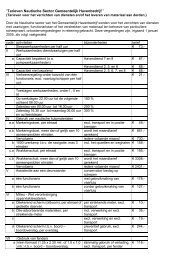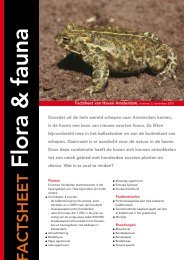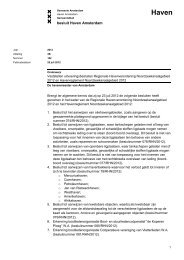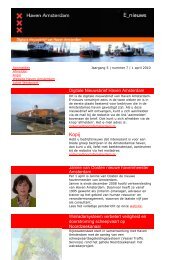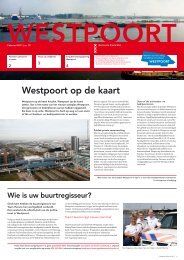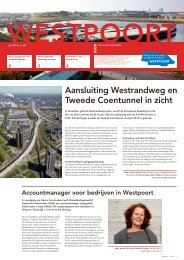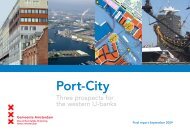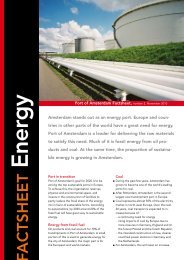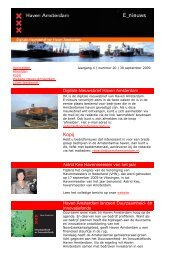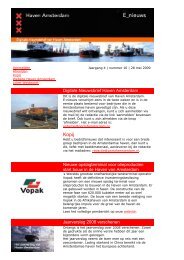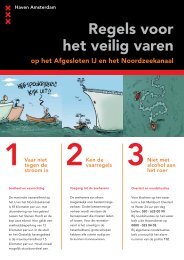You also want an ePaper? Increase the reach of your titles
YUMPU automatically turns print PDFs into web optimized ePapers that Google loves.
On the one hand, the Port of Amsterdam must<br />
maintain its competitive strength and retain its<br />
market shares in the healthy profit-generating<br />
goods segments. Only then can it continue to be<br />
an economic engine and provide jobs and revenue.<br />
On the other hand, port-related economic activities<br />
need to take place in a socially responsible and<br />
environmentally friendly manner. In <strong>2006</strong>, the Port<br />
of Amsterdam was active on four fronts: the market,<br />
physical space, better access and sustainability.<br />
The market<br />
In <strong>2006</strong>, the emphasis was very much on strengthening<br />
the Port of Amsterdam as an international<br />
logistics hub, with the aim of maintaining its longterm<br />
competitive strength and providing top-quality<br />
infrastructure and facilities. To that end, Amsterdam<br />
needs a greater number of ships and bigger volumes<br />
of cargo. Greater economies of scale allow us to<br />
charge customers competitive rates for nautical<br />
and logistics services. Likewise, this makes for<br />
attractively priced raw materials and components,<br />
which are used by manufacturing companies in<br />
the port area. Also, greater economies of scale<br />
make it possible to provide efficient and very<br />
frequent services to hinterland destinations.<br />
On many fronts, the Port performed particularly<br />
well in <strong>2006</strong>. The container sector and the energy<br />
business (oil, coal and renewables) in particular<br />
grew strongly. In addition, more ships called at the<br />
Port of Amsterdam.<br />
To serve the rapidly growing Asian market better,<br />
the Port of Amsterdam opened a permanent office<br />
in the Chinese city of Shanghai in <strong>2006</strong>. Since<br />
early <strong>2006</strong>, two container shipping services between<br />
Europe and Japan and China have used the Ceres<br />
Paragon terminal.<br />
In the Hamburg-Le Havre range of ports, the<br />
Amsterdam Ports (the Port of Amsterdam plus<br />
three nearby North Sea canal ports) market share<br />
grew from 7.0% to 7.5%. Equally noteworthy,<br />
Amsterdam Ports has now become the fourthlargest<br />
port in Northwestern Europe.<br />
Physical space<br />
The amount of land leased out by the Port increased<br />
substantially in <strong>2006</strong>. Some 80 hectares (gross)<br />
were allocated to companies active in the port area,<br />
whereas the annual average over the past ten<br />
years had hovered around 25 hectares. The Port<br />
is carefully husbanding its land resources using<br />
various means: utilizing space intensively and<br />
optimally; buying back sites no longer used; as<br />
well as restructuring existing sites. In <strong>2006</strong>, 23.7<br />
hectares of land leased out concerned restructured<br />
sites. Most of this went to Handelsveem in the<br />
Westhaven (13.6 hectares) and Greenmills in the<br />
Hornhaven (9 hectares).<br />
Companies have shown a keen interest in Atlaspark<br />
– the last port section where (dry) land is still<br />
available. In <strong>2006</strong>, the Port began discussions on<br />
the construction of a distribution center in Atlaspark<br />
with the property developer David Hart Vastgoed<br />
Groep, reaching an agreement early 2007.<br />
Better access<br />
An international logistics hub requires very good<br />
infrastructure in terms of quality and capacity.<br />
That applies to both the water-related and the<br />
land-related facilities. In <strong>2006</strong>, much progress<br />
was made in improving the port’s accessibility.<br />
The IJgeul canal was both deepened and extended.<br />
(The IJgeul canal forms the link between the<br />
sea and the North Sea Canal, which runs all the<br />
way to Amsterdam.) Furthermore, much preparatory<br />
work was done to bring forward the decision<br />
to build the much-needed second canal lock in<br />
IJmuiden (where the North Sea Canal discharges<br />
into the sea) from 2008 to the first half of 2007.<br />
In terms of land-based facilities, the Port of<br />
Amsterdam is working hard to make more<br />
intensive use of the existing infrastructure for<br />
transport to and from the hinterland. In doing<br />
so, the Port is moving away from road transport<br />
toward more sustainable modes of transport –<br />
namely barging, short-sea shipping and rail transport.<br />
In <strong>2006</strong>, various services to the hinterland<br />
by inland waterway and rail were made more<br />
frequent and were expanded. On top of that,<br />
AMSbarge was launched: in the northern part<br />
of the Randstad area, a barge sails between the<br />
Port of Amsterdam and companies located along<br />
canals/rivers to pick up and deliver containers.<br />
Finally, Port of Amsterdam, together with the<br />
Port of Rotterdam and ProRail (responsible for<br />
the Dutch rail infrastructure) took a 15% stake<br />
(to a maximum of EUR 3 million) in Keyrail – the<br />
company set up in <strong>2006</strong> to operate the Betuwe<br />
Line, which is a dedicated rail line for goods<br />
transport to the German Border.<br />
Sustainability<br />
In <strong>2006</strong>, the Port of Amsterdam launched many<br />
projects to promote sustainable development.<br />
After all, the Port can only remain a cornerstone<br />
of the regional economy, if it operates in a socially<br />
responsible and environmentally friendly fashion.<br />
The Port of Amsterdam takes a sustainable approach<br />
to land use; the transport of people and goods;<br />
fuel consumption; air quality; (the prevention of)<br />
soil contamination; as well as job creation for a<br />
diversified workforce. One example of sustainable<br />
development is the creation of a large wind farm<br />
in the port area. Further to that, Greenmills will<br />
recycle organic waste flows to produce bio-fuels.<br />
Also, Harvest Energy concluded a contract for the<br />
construction of a bio-ethanol plant in the port area<br />
(also see page 40).



